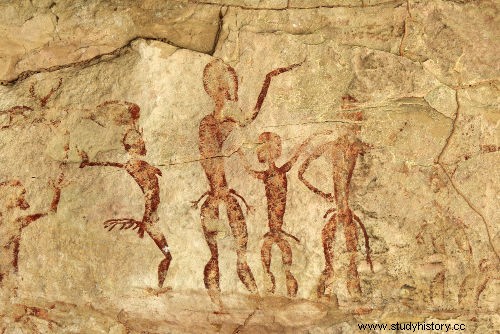
What is Prehistory?
Prehistory is a period comprising approximately five million years, having ended around 6000 BC. This period is the subject of multidisciplinary studies, that is, it involves specialists such as archaeologists, biologists, paleontologists, chemists, historians, etc. But in terms strictly restricted to historiographical language (used by professional historians), Prehistory can be qualified as the period before the appearance of cities (urban organization) and writing . This long period is generally divided into two phases:the Paleolithic, or Chipped Stone Age, and Neolithic, or Polished Stone Age.
Prehistoric man
Generally, in an attempt at a precarious definition, we tend to call our ancestors of the period in question “prehistoric men”. But there is a more appropriate name for this:hominids . Hominids belong to a taxonomic family classified by Biology and titled hominidae . We humans are within this “family”, just like chimpanzees. However, we are not of the chimpanzee species, much less the hominids that preceded us.
Hominids were able, over millions of years, to develop complex tools and household items. They managed to master fire, which came to be used both for heating and cooking food, and they even managed to do the most extraordinary thing:to develop symbolic systems, such as urns and burial chambers, sculptures and cave paintings.
These hominids can be divided in chronological order. The oldest belong to the group Ardipithecus ramidus, whose appearance proved by archeology varies from 5 to 4 million years. There is also another example, Australopithecus afarensis, whose appearance on Earth varies between 3.9 and 3 million years. On the other hand, there was, later, the emergence of the Homo genre. There was, for example, the Homo habilis , which lived between 2.4 and 1.5 million years ago. The Erectus Man , between 1.8 million and 300 thousand years. Then the Homo neanderthalensis , between 230 and 30 thousand years. We humans belong to the group Homo sapiens, which appeared probably around 120,000 years ago.
Paleolithic and Neolithic
The Paleolithic period is the longest, going from 3 million BC. up to 10,000 BC. It is characterized by nomadism and the still precarious use of utensils. It was in this period that the hominids exposed above appeared. In the Neolithic , the second and most important phase of prehistory, the “polished stone” revolution took place, which made possible a sedentary lifestyle and the first forms of systematic agriculture. It was within the “Neolithic revolution” that Homo sapiens was born and, consequently, the first civilizations, characterized by the smelting of metals, such as copper and iron.
By me. Claudio Fernandes
